Contents
Autumn honey agaric (Armillaria mellea; Armillaria borealis)
- Division: Basidiomycota (Basidiomycetes)
- Subdivision: Agaricomycotina (Agaricomycetes)
- Class: Agaricomycetes (Agaricomycetes)
- Subclass: Agaricomycetidae (Agaricomycetes)
- Order: Agaricales (Agaric or Lamellar)
- Family: Physalacriaceae (Physalacriae)
- Genus: Armillaria (Agaric)
- Type: Armillaria mellea; Armillaria borealis (Autumn honey agaric)
- Real honey agaric
- Honey mushroom
- Honey agaric
- Honey agaric northern
:
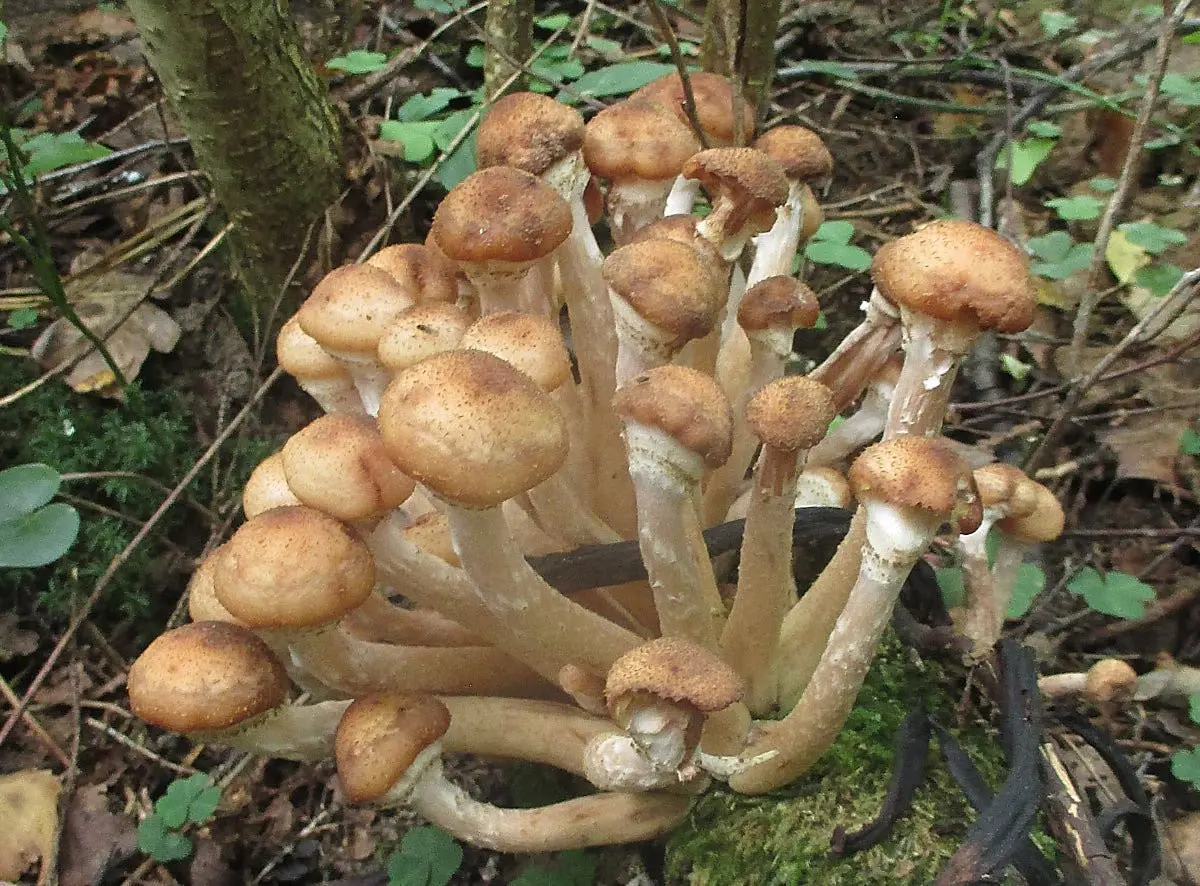
The autumn honey agaric includes two species that are almost indistinguishable in appearance, these are the autumn honey agaric (Armillaria mellea), and the northern autumn agaric (Armillaria borealis). This article describes both of these types at the same time.
:
- Honey mushroom autumn
- Agaricus melleus
- Armillariella mellea
- Omphalia mellea
- Omphalia var. honey
- Agaricites melleus
- Lepiota mellea
- Clitocybe mellea
- Armillariella olivacea
- Sulphurous agaric
- Agaricus versicolor
- Stropharia versicolor
- Geophila versicolor
- Fungus versicolor
:
- Honey agaric autumn northern
head diameter 2-9 (up to 12 in O. northern, up to 15 in O. honey) cm, very variable, convex, then flat-prostrate with curved edges, with a flat depression in the center, then the edges of the cap can bend up. The color range of coloring is extremely wide, on average, yellowish-brown, sepia colors, with different shades of yellow, orange, olive and gray tones, of the most different strength. The center of the cap is usually darker colored than the edge, however, this is not due to the coloration of the cuticle, but due to denser scales. The scales are small, brown, brown or the same color as the cap, disappearing with age. The partial spathe is dense, thick, felt, whitish, yellowish, or cream, with white, yellow, greenish-sulfur-yellow, ocher scales, becoming brown, brown with age.
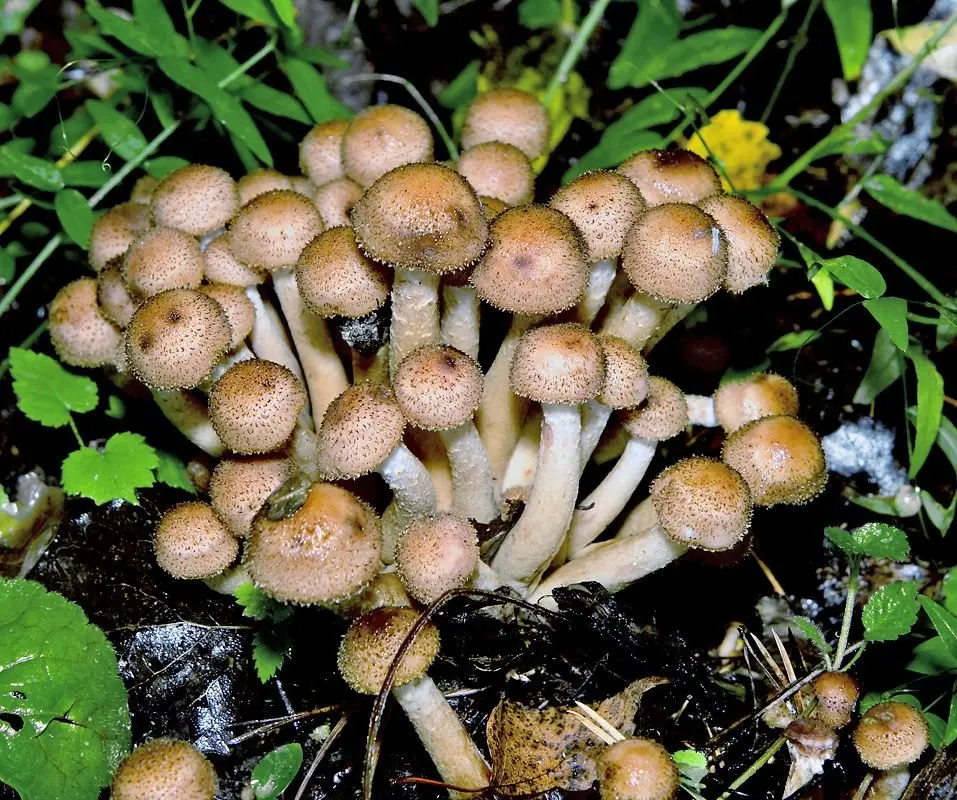
Pulp whitish, thin, fibrous. The smell is pleasant, mushroom. According to various sources, the taste is either not pronounced, ordinary, mushroom, or slightly astringent, or reminiscent of the taste of Camembert cheese.
Records slightly descending to the stem, white, then yellowish or ocher-cream, then mottled brown or rusty brown. In the plates, from damage by insects, brown spots are characteristic, caps appearing upwards, which can create a characteristic pattern of brown radial rays.
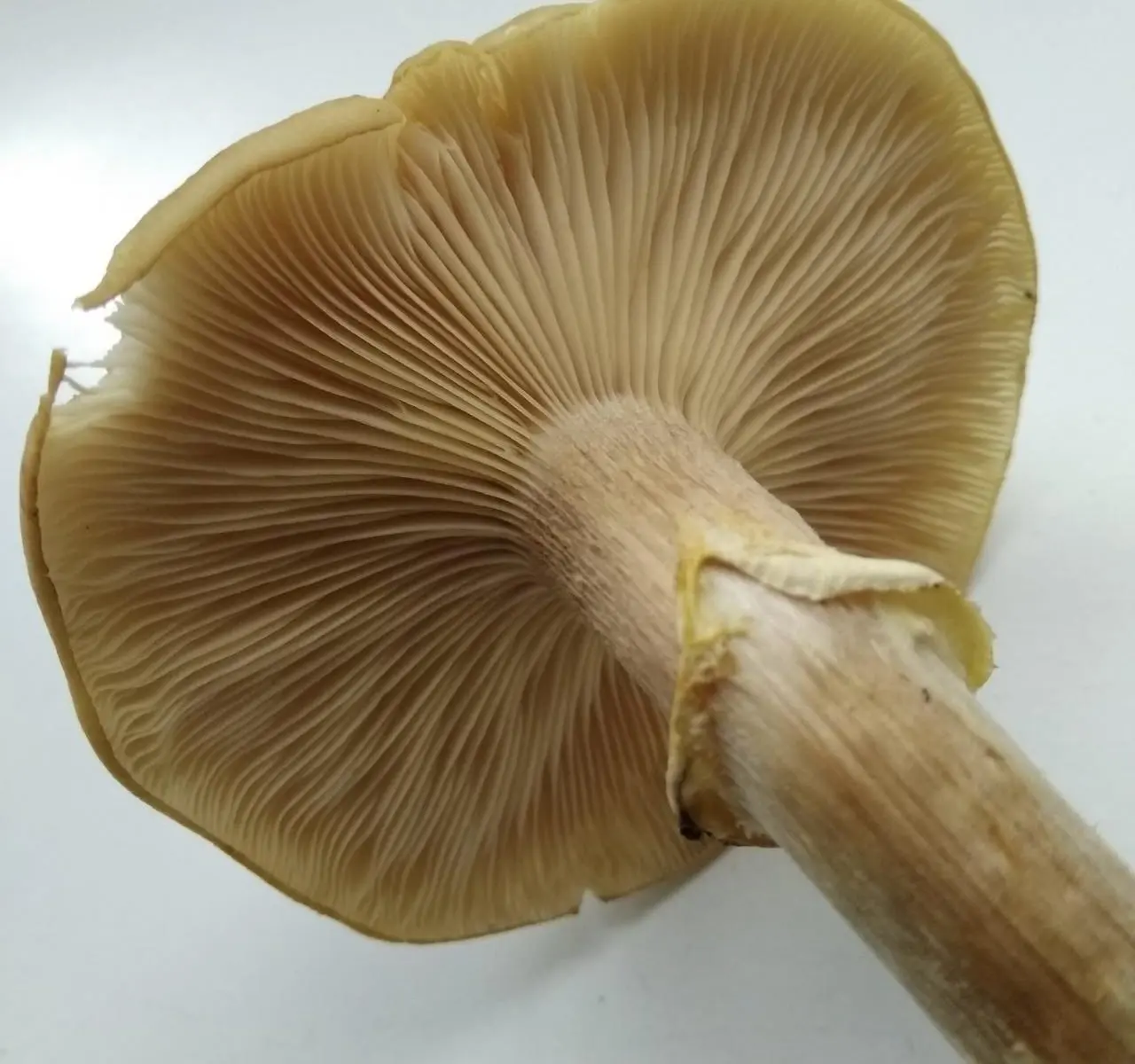
spore powder white.
Споры relatively elongated, 7-9 x 4.5-6 µm.
Leg height 6-10 (up to 15 in O. honey) cm, diameter up to 1,5 cm, cylindrical, may have a spindle-shaped thickening from below, or simply thicken below up to 2 cm, the colors and shades of the cap are somewhat paler. The leg is slightly scaly, the scales are felt-fluffy, disappearing with time. There are powerful, up to 3-5 mm, black, dichotomously branching rhizomorphs that can create a whole network of huge sizes and spread from one tree, stump or deadwood to another.
Interspecies differences O. northern and O. honey – Honey agaric is more confined to the southern regions, and O. northern, respectively, to the northern ones. Both species can be found in temperate latitudes. The only clear difference between these two species is a microscopic feature – the presence of a buckle at the base of the basidia in O. northern, and its absence in O. honey. This feature is not available for verification by the vast majority of mushroom pickers, therefore, both of these species are described in our article.
It bears fruit from the second half of July, and until the end of autumn, on wood of any kind, including those located underground, in clusters and families, up to very significant ones. The main layer, as a rule, passes from the end of August to the third decade of September, does not last long, 5-7 days. The rest of the time, fruiting is local, however, a fairly significant number of fruiting bodies can be found at such local points. The fungus is an extremely serious parasite of forests, it passes to living trees, and quickly kills them.
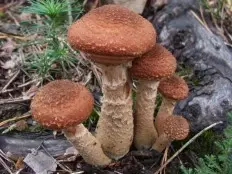
Dark honey agaric (Armillaria ostoyae)
The mushroom is yellow in color. Its scales are large, dark brown or dark, which is not the case with the autumn honey agaric. The ring is also dense, thick.

Thick-legged honey agaric (Armillaria gallica)
In this species, the ring is thin, tearing, disappearing with time, and the cap is approximately evenly covered with rather large scales. On the leg, yellow “lumps” are often visible – the remains of the bedspread. The species grows on damaged, dead wood.
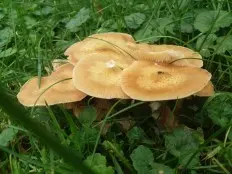
Bulbous mushroom (Armillaria cepistipes)
In this species, the ring is thin, tearing, disappearing with time, like in A.gallica, but the cap is covered with small scales, concentrated closer to the center, and the cap is always naked towards the edge. The species grows on damaged, dead wood. Also, this species can grow on the ground with the roots of herbaceous plants, such as strawberries, strawberries, peonies, daylilies, etc., which is excluded for other similar species that have a stalk ring, they require wood.

Shrinking honey agaric (Desarmillaria tabescens)
и Honey agaric social (Armillaria socialis) – Mushrooms do not have a ring. According to modern data, according to the results of phylogenetic analysis, this is the same species (and even a new genus – Desarmillaria tabescens), but at the moment (2018) this is not a generally accepted opinion. So far, it is believed that O. shrinking is found on the American continent, and O. social in Europe and Asia.
Some sources indicate that mushrooms can be confused with certain types of scales (Pholiota spp.), As well as with representatives of the genus Hypholoma (Hypholoma spp.) – sulfur-yellow, gray-pastoral and brick-red, and even with some Galerinas (Galerina spp.). In my opinion, this is almost impossible to do. The only similarity between these mushrooms is that they grow in the same places.
Edible mushroom. According to various opinions, from mediocre taste to almost a delicacy. The pulp of this mushroom is dense, poorly digestible, so the mushroom requires a long heat treatment, at least 20-25 minutes. In this case, the mushroom can be cooked immediately, without preliminary boiling and draining the broth. Also, the mushroom can be dried. The legs of young mushrooms are as edible as the caps, but with age they become woody fibrous, and when collecting age mushrooms, the legs should not be taken categorically.
Video about mushroom mushroom autumn:
In my personal opinion, this is one of the best mushrooms, and I always wait for a layer of mushrooms to come out and try to get those that have a ring still not torn off the cap. At the same time, nothing else is needed, even white ones! I love to eat this mushroom in absolutely any form, both fried and in soup, and pickled is just a song! True, the collection of these mushrooms can be routine, in the case when there is no particularly abundant fruiting, when with one movement of the knife you can throw four dozen fruiting bodies into the basket, but this more than pays off with their excellent (for me) taste, and excellent, firm and crunchy texture , which many other mushrooms will envy.









